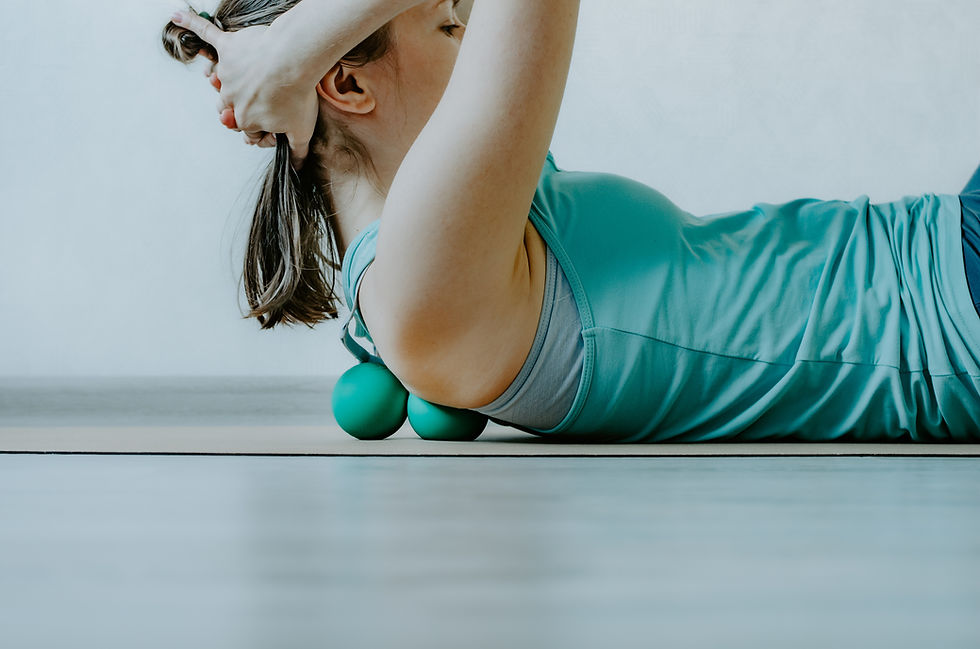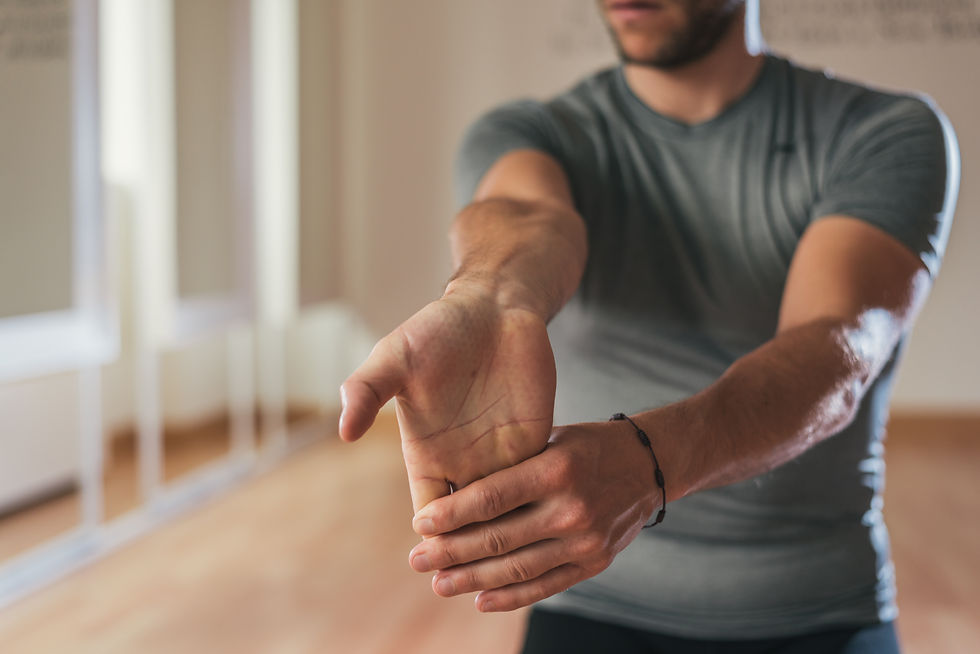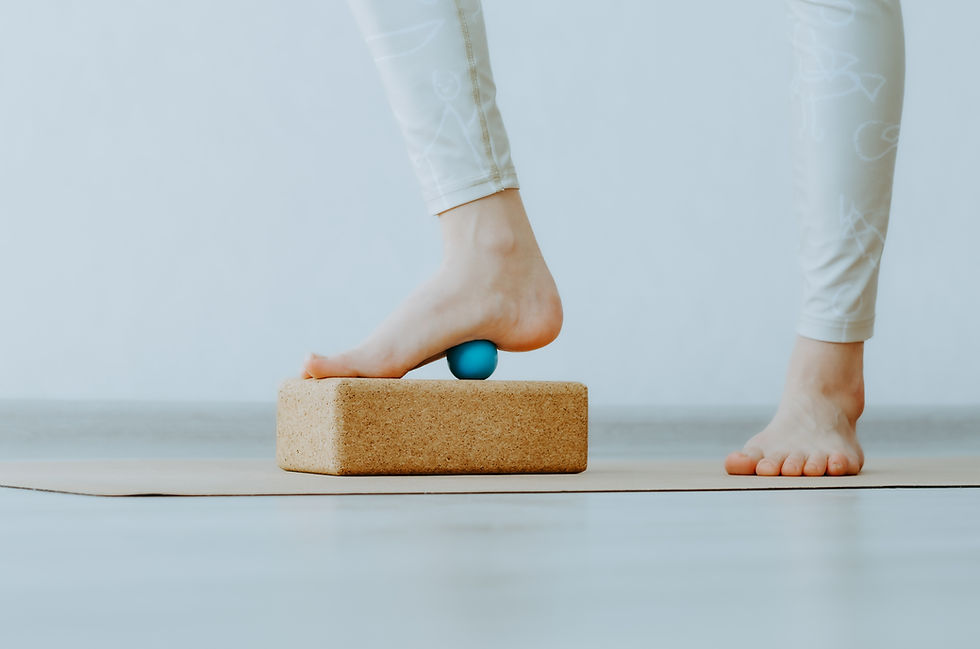How Stretching and Myofascial Release Improve Fascia Health, Mobility, and Internal Wellness
- Joy Zazzera

- Dec 7, 2022
- 6 min read
Updated: Aug 1
The human body is a complex tension-integral system where push and pull have a win-win relationship. More simply, the body is bones connected by soft tissue within a net of continuous tension creating stability without direct contact. When the tension network shifts, it affects the entire system and has impacts on efficiency of movement, and propensity to injury. In the movement science world, this concept is known as biotensegrity.
From deep to superficial, this tension system is comprised of bone, cartilage, joint capsules, ligaments - all creating passive stability - and then, tendon and muscle, as the active stabilizers. Our actions and our life experiences in our very human bodies are sensed and adjusted via our FASCIA - the human body’s richest sensory organ.

Fascia is intelligent, efficient, body-wide, living, aqueous tissue that listens and responds, and supports and adapts. Fascia is made for economy of movement and is resilient to our endeavors over time. Serving a variety of functions, fascia appears as a continuous stream of fibrous tissue giving muscles shape, connecting muscles to other muscles and bone and generally holding everything in place on your skeleton. The increasing number of research studies on fascia through the years has elevated this body-wide fabric matrix to becoming the number one sensory organ in the human body, taking the title of the body’s top sensory tissue away from skin, now our number two most dominate sensory organ.

From Anatomy to Application: The Science Behind Myofascial Release & Stretching
As a yoga teacher turned human anatomy and physiology nerd, my teachings emphasize yoga’s comprehensive benefits to internal health. Continued studying of movement and recovery implications on our fascia inform the array of therapeutic tools I teach students - such as self-myofascial release. Self Myofascial Release (SFMR) commonly associated with tools like foam rolling and therapy balls, provides soft tissue therapy for releasing tension in fascia that restricts movement in our bodies.

Through techniques like compression - also known as sinking pressure -and shearing and flushing we are able to stimulate receptors on our body that help muscle and tissue relax and lengthen. Longer muscles and less tension lead to all kinds of good things like easing compressive forces on joints, wider range of motion and increased mobility. It is these very techniques through which I teach mindfulness, presence and interopception - our ability to sense our own internal condition.
Mechanically speaking, when we apply a stimulus to the body via a stretch or compression, we test our tissues ability to lengthen and return, stir fascia’s viscous ground substance to become more pliable and resilient, stimulate our fibroblasts to regulate their synthesis of collagen and other extracellular matrix proteins in response to mechanical tension. Ground substance is made up fluids and fill spaces between fascia’s fibers and cells. One of these proteins is Hyaluronic Acid. With age, we produce less fibroblasts - the main cells of fascia - and consequently less hyaluronic acid as the viscous fluid stiffens and reduces our sense of mobility. However, viscous fluid becomes less viscous when agitated, sheered or stressed, giving us the autonomy to regulate connective tissue hydration and fascial health and mobility with specific, targeted techniques. There is even new evidence of fascia’s influence beyond our musculoskeletal system to include our nervous, lymphatic and cardiovascular systems.
For example, a 2020 meta-analysis by Kato et all, studied The effects of stretching exercises on arterial stiffness in middle-aged and older adults and found positive effects on the vascular system. Vascular endothelial function increased and arterial stiffness, heart rate, diastolic blood pressure were all reduced by a regular stretching routine. Foam rolling - a form of self-applied myofascial release - also reduced arterial stiffness as well as increasing nitric oxide. Nitric Oxide, produced by endothelial cells, helps to modulate vasodilation, regulate local cell growth and plays a big role in endothelial function. This study, and an increasing amount of new research like it, provide scientific evidence on the benefits of taking a little an often approach when it comes to yoga and yoga therapeutics like SMFR.

Stretching and Fascia Care for Aging Bodies
As we age, we produce fewer fibroblasts, and the ground substance in our fascia becomes more viscous and less responsive. This leads to:
Stiffness in joints and muscles
Less efficient movement
Greater risk of injury
Decreased internal hydration
But here’s the good news: targeted stretching and SMR can counteract these changes. When performed regularly, they help preserve joint space, ease compressive forces, and rehydrate connective tissues—all of which help you move and feel better in your body.
Why Yoga Therapeutics is an Ideal Practice for Fascia and Internal Health
Yoga, when taught with an understanding of fascia, becomes far more than poses—it becomes a pathway to whole-body resilience. In my classes, I combine yoga with targeted self-myofascial release techniques that support the entire system:
Glutes and hips for lumbar support
Feet and palms for full-body fascial lines
Abdomen and diaphragm for breath and vagal tone
Shoulders, spine, and skull to release upper tension
These aren't generic foam rolling routines. They're fascia-informed, nervous system-aware, and deeply empowering tools that help you regulate tension, reduce inflammation, and reconnect with your body’s internal cues.
Students who take my classes report back that their most-often self-applied yoga therapeutic tool outside of classes is indeed self-myofascial release. From feet and palms, the abdomen, lumbar stabilizers, glutes, the outer and inner hips, back and front of the legs, up along the spinal muscles into the skull, around the shoulder cage, under the armpits to the backs of the arms - self myofascial release is a highly effective way to form a better connection with your body and directly influence your inner condition. For athletes, self myofasical release is evidenced as relief for delayed onset muscles soreness (DOMS) and not only can be a critical recovery tool but research also shows that SMF is an efficient way to warm up the body prior to activity without the athlete experiencing any negative performance deficits.
Interested in learning more? My yoga classes provide a therapeutic experience well beyond moving through yoga poses.

Students who enjoy my classes practice for a feeling, not a look. They're drawn to inner experience, learning to explore and self-apply techniques that bring real-time relief. They’ve discovered that yoga doesn’t have to look a certain way to be effective—it just has to work. With myofascial release, they’ve found a simple, practical tool they can use anytime to reconnect, recenter, and feel better in their bodies. When combined with yoga, SMR deepens presence and makes each practice more meaningful and lasting. .

References
Katja Bartsch, Sports Scientist & lead Yoga Medicine Researcher. Yoga Medicine Research Lecture Notes.
Tiffany Cruikshank, Yoga Medicine Founder, Lead Teacher; Yoga Medicine Research Lecture Notes.
Kato M., Nihei Green F, Hotta K, Tsukamoto T, Kurita A, Takaagi H. The Efficacy of Stretching Exercsises on Arterial Stiffness in Middle-Aged and Older Adults: A Meta-Analysis of Randominzed aand Non-Randomized Controlled Trials. Int j Environ Res Public Health. 2020 Aug 5; 17(16):5643. doi: 10.3390/ijerph17165643. PMCID: PMC7460052.
Okamoto T, Masuhara M, Ikuta K. Acute effects of self-myofascial release using a foam roller on arterial function. J Strength Cond Res. 2014 Jan;28(1):69-73. doi: 10.1519/JSC.0b013e31829480f5. PMID: 23575360.
Tousoulis D, Kampoli AM, Tentolouris C, Papageorgiou N, Stefanadis C. The role of nitric oxide on endothelial function. Curr Vasc Pharmacol. 2012 Jan;10(1):4-18. doi: 10.2174/157016112798829760. PMID: 22112350.







Comments